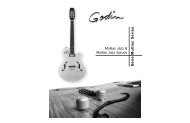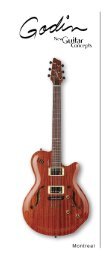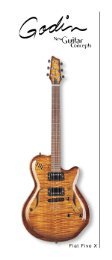Finale 2004a - [Walkin' Bass for Guitarists] - Godin Guitars
Finale 2004a - [Walkin' Bass for Guitarists] - Godin Guitars
Finale 2004a - [Walkin' Bass for Guitarists] - Godin Guitars
Create successful ePaper yourself
Turn your PDF publications into a flip-book with our unique Google optimized e-Paper software.
Walking <strong>Bass</strong> Lines <strong>for</strong> <strong>Guitarists</strong><br />
© by Mark White<br />
Whitmark Music Publishing<br />
<strong>Bass</strong> lines are an excellent means to improve your musicianship on the guitar, or any other instrument. Learning to improvise/write<br />
bass lines offers several benefits including:<br />
1. Provides a solid, swinging accompianiment <strong>for</strong> duo and creation of practice play-along sequences, recordings, etc...<br />
2. Helps to develop an intuitive sense of harmonic rhythm (chord changes) by orienting to the bass line.<br />
3. <strong>Bass</strong> lines incorporate many "basic" improvisational concepts and fundamental musical building blocks such as chord tone outlining<br />
with chromaticism, bop scales, and use of sequence that are essential tools <strong>for</strong> improvising in the jazz/fusion idioms.<br />
Step One Root and Fifth Orientation<br />
Begin with a quarter note "walking" bass line utilizing primarily the 1st and 3rd fingers. Connect the chord changes, experimenting with<br />
different string groups but stay on the low side. You should be able to do this with any progression at sight in meter. Alter any fifths as<br />
directed, such as b5 (Many times a # 5 iin the chord symbol is really a b13 and the fifth in the bass line should be a natural 5). It is<br />
essential to have mastered your basic chord construction in 12 keys.<br />
All the Things... changes<br />
Ex 1<br />
F-7<br />
& bb b b 4 4 œ<br />
œ<br />
œ<br />
œ<br />
Bb -7<br />
œ<br />
œ<br />
œ<br />
œ<br />
Eb 7<br />
œ<br />
œ<br />
œ<br />
œ<br />
Ab± 7<br />
œ<br />
œ<br />
œ<br />
œ<br />
Db± 7<br />
D-7 G7<br />
C± 7<br />
œ<br />
& bb b b œ<br />
œ<br />
œ<br />
œ<br />
nœ<br />
nœ<br />
œ<br />
œ<br />
œ<br />
œ<br />
œ<br />
œ<br />
œ<br />
œ<br />
œ<br />
Step Two Root and Fifth with Chromatic approach<br />
*A temporary rule <strong>for</strong> starting out-when the chord changes play the root, then the root or fifth can be approached chromatically from above<br />
or below. Work backwards from the root as in the following examples.<br />
Ex 2a<br />
& b b b b œ<br />
Ex 2b<br />
& b b b b œ<br />
F-7<br />
F-7<br />
Roots only<br />
Œ<br />
Œ<br />
Œ<br />
Ó<br />
nœ<br />
Bb -7<br />
œ<br />
chromatic approach to root Bb -7<br />
bœ<br />
Œ<br />
Œ<br />
Œ<br />
Ó<br />
nœ<br />
Eb 7<br />
œ<br />
bœ<br />
Eb 7<br />
Œ<br />
Œ<br />
Ó<br />
Œ<br />
œ<br />
Ab± 7<br />
Œ<br />
œ<br />
Ab± 7<br />
Œ<br />
œ<br />
Œ<br />
Ó<br />
œ
Ex 2c add the fifth<br />
F-7<br />
& bb b b œ<br />
Œ<br />
œ<br />
nœ<br />
Bb -7<br />
bœ<br />
Œ œ nœ<br />
bœ<br />
Eb 7<br />
Œ<br />
œ<br />
œ<br />
Ab± 7<br />
œ<br />
Œ<br />
œ<br />
œ<br />
Ex 2d approach the fifth<br />
& bb b b œ<br />
F-7<br />
œ œ nœ<br />
Bb -7<br />
bœ<br />
bœ<br />
œ nœ<br />
Eb 7 Ab± 7<br />
bœ<br />
nœ<br />
œ œ œ nœ<br />
œ œ<br />
Ex 3 vamp with 2 changes per bar (notice the root where chord changes)<br />
E-7 A7<br />
D-7 G7<br />
& . ΠΠΠΠ.<br />
œ œ œ<br />
œ<br />
C C C C<br />
C= chromatic aproach above/below<br />
Ex 4 4 changes per bar (roots only)<br />
E-7 A7 D-7 G7<br />
&<br />
œ œ œ<br />
œ<br />
practice the vamp with all approaches from above, then all from below,<br />
then mixing both directions.<br />
Note:<br />
In situations where the chord duration is multiple bars<br />
the root only needs to be hit on the initial occurance of<br />
the chord.<br />
We're still using the" when chord changes play the root" rule <strong>for</strong> the time being. It will simplify the adding of chords to the bass line.<br />
The first 8 bars of "All the Things..." might look like this:<br />
Ex 5<br />
& b b b b œ<br />
F-7<br />
œ œ nœ<br />
Bb -7<br />
bœ<br />
bœ<br />
œ nœ<br />
Eb 7 Ab± 7<br />
bœ<br />
nœ<br />
œ œ œ nœ<br />
œ œ<br />
& b b b b<br />
Db± 7<br />
bœ<br />
œ œ œ<br />
D-7 G7<br />
nœ<br />
œ œ nœ<br />
C± 7<br />
œ # œ œ bœ<br />
œ<br />
œ<br />
œ<br />
nœ<br />
This method works well, but you'll notice the line is a littly "jerky". To smooth up the line lets go on to the next big<br />
building block <strong>for</strong> bass lines which is scales and scales with chromatics.<br />
Mark White's Walking <strong>Bass</strong> P-2
Step Three Scales and Scales with Chromatics<br />
Any basic chord scale intended <strong>for</strong> bass line application can be used by itself or enhansed by the use of chromatics.<br />
Ex 6<br />
G7 Mixolydian<br />
&<br />
w w w w w w w w<br />
Ex 6a<br />
G7<br />
Mixolydian with added chromatics<br />
&<br />
œ œ # œ œ<br />
œ<br />
# œ œ œ<br />
Start with the basic major, dorian, and mixolydian scales and try adding chromatic connectors between scale steps<br />
2-3 4-5 b7-1.<br />
& bb b b œ œ œ nœ<br />
Bb -7<br />
œ œ œ nœ<br />
œ œ œ œ<br />
œ<br />
œ<br />
etc.<br />
Ex 6b<br />
F-7<br />
Ab± 7<br />
Eb 7<br />
œ œ nœ<br />
Db± 7<br />
Too much scale with chromicism can get a bit too smooth and wishy-washy.<br />
Step Four Chord tone outline by triads/7th chord<br />
Ex 7<br />
F-7<br />
& b b b b œ œ œ œ<br />
Bb -7 Eb 7 Ab± 7<br />
œ<br />
œ œ œ œ œ œ<br />
œ œ œ œ œ<br />
Too much chord tone outling especially the triadic, can make you feel like you're caught in a bad elvis presly movie!<br />
But, there's still great potential <strong>for</strong> musicality through manipulation of the chord tones. The chord outline doesn't<br />
always have to go 1357, try 1537, 1753, etc.<br />
etc<br />
With the inversions of the chord tones available you can see the potential <strong>for</strong> non-root on the change that will become possible.<br />
Steps two, three, and four are the basics of bass line construction. You'll find, though, to keep things interesting frequent<br />
juxtaposition of the different components is necessary to keep things fresh and musical. The following is an example of the three<br />
ingredients at work in "All the Things..."<br />
Mark White's Walking <strong>Bass</strong> P-3
Notice that scale fragments such as 1235 or even a plain scale without chromatics can be used to<br />
connect chords very effectively.<br />
Ex 8<br />
F-7<br />
& bb b b .<br />
œ œ œ nœ<br />
Db± 7<br />
& bb b b œ œ œ œ<br />
C-7<br />
& bb b b œ œ œ nœ<br />
Ab± 7<br />
& bb b b œ œ œ œ<br />
A-7<br />
& bb b b nœ<br />
F # -7<br />
nœ<br />
œ bœ<br />
& bb b b # œ # œ nœ<br />
F-7<br />
# œ<br />
& b b b b œ œ œ œ<br />
Bb -7 Eb 7<br />
œ œ œ nœ<br />
œ œ œ œ<br />
D-7 G7<br />
nœ<br />
œ œ nœ<br />
F-7<br />
œ<br />
nœ<br />
œ œ œ<br />
A-7 D7<br />
D7<br />
nœ<br />
B7<br />
nœ<br />
# œ nœ<br />
bœ<br />
nœ<br />
# œ nœ<br />
# œ<br />
# œ<br />
# œ<br />
Ab± 7<br />
C± 7<br />
œ<br />
œ œ œ<br />
‘<br />
œ nœ<br />
œ nœ<br />
œ # œ œ<br />
Bb 7 Eb± 7<br />
nœ<br />
œ œ œ œ œ nœ<br />
œ<br />
G± 7 B-7 E7<br />
œ<br />
œ # œ œ<br />
G± 7<br />
nœ<br />
nœ<br />
œ nœ<br />
# œ<br />
œ # œ nœ<br />
nœ<br />
œ<br />
nœ<br />
nœ<br />
œ<br />
E± 7 G-7b5 C7( 5)<br />
nœ<br />
# œ œ # œ nœ<br />
bœ<br />
œ bœ<br />
Bb -7 Eb 7 Ab± 7<br />
œ œ œ nœ<br />
œ œ œ œ œ œ œ œ<br />
& b b b b Db± 7<br />
Db -7 Gb 7 C-7 F7 B-7 E7<br />
œ œ œ œ<br />
œ<br />
œ bœ<br />
nœ<br />
œ bœ<br />
œ bœ<br />
nœ<br />
œ nœ<br />
nœ<br />
& b b b b Bb -7 Eb 7 Ab± 7<br />
G-7b5 C7b 9<br />
.<br />
œ œ œ nœ<br />
œ nœ<br />
œ œ œ œ œ œ œ<br />
œ œ bœ<br />
Mark White's Walking <strong>Bass</strong> P-4
Step Five Variation of basic elements<br />
You can get a lot more musical mileage out of the basic building devices by applying these variations to your bass lines.<br />
Ex 9A. Sequence-here's a simple scale fragment plugged into a minor blues.<br />
C-7<br />
& œ œ<br />
bœ<br />
œ<br />
œ<br />
‘<br />
bœ<br />
œ œ bœ<br />
‘<br />
œ œ œ œ<br />
œ<br />
‘<br />
bœ<br />
C7(b 9)<br />
nœ<br />
F-7<br />
œ<br />
Ex 9B. Doubled notes-check out bassist charlie haden <strong>for</strong> good examples of this device.<br />
G7<br />
& œ œ œ œ<br />
cliche bass line<br />
œ œ bœ<br />
œ<br />
etc.<br />
B± 7 D7<br />
& œ œ œ œ<br />
"steps changes"<br />
G± 7 Bb 7<br />
œ œ bœ<br />
œ œ<br />
Eb± 7 A-7 D7<br />
œ œ œ œ<br />
b œ œ bœ<br />
Ex 9C. large interval skips by 10th, 9th, octave, and 7th<br />
G7 F # 7<br />
& œ # œ œ<br />
#œ<br />
F7<br />
nœ<br />
E7<br />
œ œ<br />
fragment from a blues progression utilizing octaves<br />
œ<br />
A-7<br />
œ œ œ # œ<br />
D7<br />
œ<br />
# œ œ # œ<br />
G7<br />
œ<br />
Ex 9D. "the secret weapon" Percusive/rhythmic effects. Up 'till this point all of our bass line generators have been pitch-oriented. Another<br />
way to create interest, variation, and rhythmic "drive" utilizes what i call the "flam". Think like a jazz drummer improvising reactive "hits"<br />
using the snare drum. The "abstractions" as some drummers call them are reactions to the music and also a way to heat up the interplay<br />
between the per<strong>for</strong>mers. We don't really relate the pitch of a snare drum to a song's tonality, and in the same way, we can use rhythmic<br />
effects percusively on the guitar using open strings and chord shapes without affecting the music's tonality in a negative way.<br />
& 3<br />
&<br />
œ<br />
j<br />
œ œ # œ œ œ # œ œ œ<br />
j<br />
"<br />
"<br />
œ<br />
‹<br />
¿ œ<br />
œ<br />
open string pull-off<br />
chord group with no pressure <strong>for</strong> muffled sound<br />
Mark White's Walking bass P-5
<strong>Bass</strong>ist ron carter is a master of these effects on double bass-check out the way he uses them! We guitarists benefit from these<br />
effects by "disguising" the elements we're using rhythmically. And you get drive as well as the suprise factor. Try to use these<br />
effects randomly so they're unpredictable.<br />
We now have the basic elements to make good bass lines. Of course, these ideas are pretty theory oriented. To make these elements<br />
come-alive musically you need to listen to good examples of the art of bass-playing. In addition to great double bass players like: Ron<br />
Carter, Paul Chambers, Percy Heath, Niels- Henning Orsted Pedersen, Ray Brown, etc. check out modern players like: Jeff Andrews,<br />
Lincoln Goines, and so on. TRANSCRIBE!!! Find out what's going on with your ears! WRITE!!! Practice writing bass lines on tunes. Start<br />
with the blues or a simple jazz standard like "Summertime", and scrutinize your written lines <strong>for</strong> good content. USE THE ERASER AS<br />
MUCH AS THE LEAD IN YOUR PENCIL!!!<br />
PLAY WHAT YOU WRITE, and work on the groove and feel. Try playing a line only on one string, then two, then three, whatever, and<br />
SING WHAT YOU PLAY!!<br />
You'll be surprised what a great "orientation exercise" this is. Try to relate these ideas to your improvisations. Re-organizing the<br />
fingerboard in this manner with these elements is a great rut-buster!!<br />
One last idea <strong>for</strong> this lesson-listen to jazz organ players like Larry Young. Organists tend to play what i call functunal bass lines.<br />
Basic elements-while swinging their tails off! We guitarists can learn a lot from them.<br />
Next Lesson: <strong>Bass</strong> Lines part 2<br />
Adding chords to your bass lines<br />
MW in Perugia-7<br />
Mark White is an Associate<br />
Professor/traveling clinician <strong>for</strong><br />
Berklee College of Music in Boston.<br />
He's an endorsee <strong>for</strong> <strong>Godin</strong> <strong>Guitars</strong><br />
Mark White's walking bass P-6


![Finale 2004a - [Walkin' Bass for Guitarists] - Godin Guitars](https://img.yumpu.com/34300061/1/500x640/finale-2004a-walkin-bass-for-guitarists-godin-guitars.jpg)


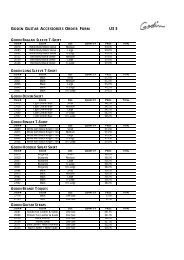
![Finale 2004a - [Quartal Harmony bullets p-5] - Godin Guitars](https://img.yumpu.com/41748475/1/190x245/finale-2004a-quartal-harmony-bullets-p-5-godin-guitars.jpg?quality=85)
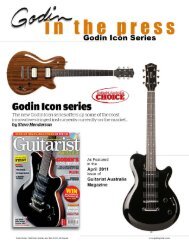


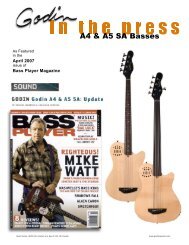

![Finale 2003 - [Tension Chart] - Godin Guitars](https://img.yumpu.com/24190023/1/190x245/finale-2003-tension-chart-godin-guitars.jpg?quality=85)
